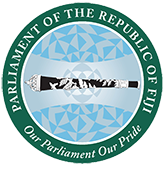History of the Parliament of the Republic of Fiji
The first attempt to set up something resembling a parliament was in 1871. One of the leading chiefs at that time, Ratu Seru Cakobau and a group of influential European settlers tried to set up a government in Levuka, Ovalau. The Westminister-style Legislative Assembly met for the first time in Levuka that year. The government did not last due to accumulation of debt and political uncertainty.
On 10th October 1874 Fiji was ceded to Great Britain. Fiji was proclaimed a British Colony and was subsequently administered by a Governor, through the Legislative Council, as a possession and dependant of the British Crown.
The first step towards Fiji’s progress to Independence and parliament democracy showed sign 1964 when the Membership System of Government was first introduced in Fiji with elections for Members of the Legislative Council who were given specific portfolios.
In July 1965, a constitutional conference was held in London to discuss further progress towards independence and self-government.
A ministerial system of government was introduced in Fiji in 1967 after the first national elections in 1966. This was a system adopted from Westminster Parliament and UK Government where the Ministers controlling government departments were introduced. This was the first time elections were held on party line where two major political parties, Federation Party and Alliance Party contested the election. Ratu Sir Kamisese Mara of took up the office of Chief Minister after his Alliance Party won the majority seats in the Legislative Council. In 1968 there were altogether 8 Ministers and 4 Assistant Ministers.
After the second constitutional conference held between April and May in 1970 in London, the representative of the two major political parties were able to agree on an acceptable formula and Fiji’s’ independence was announced.
On 10th October, 1970 Fiji was given independence and gained dominion status. On 27th November, 1970 at , the Governor-General Sir Robert Sidney Foster, addressed a joint sitting of the House of Representatives and the Senate to officially open Fiji’s first ever Parliament. The members of the former Legislative Council had become members of the new Parliament. A bi-cameral legislature under the 1970 Constitution was adopted. Ratu Sir Kamisese Mara the former Chief Minister became the first Prime Minister and members of the Alliance Party formed the cabinet consisting of 9 ministers and 5 assistant ministers. The National Federation Party formed the first Opposition with Siddiq M. Koya the first Opposition Leader.
The first general election after independence was held in April, 1972. Ratu Mara’s Alliance Party won 33 out of the 52 seats, while NFP took the remaining 19 seats in the House of Representatives. Ratu Mara was elected as Prime Minister, while Mr Koya reaffirmed his position as Leader of the Opposition. On 12th May, 1972, Governor-General Sir Robert Foster, addressed the first elected House of Representatives and appointed senators.
Parliamentary democracy was disrupted by a military-led coup in 1987. The parliamentary democracy returned in 1992 under the 1990 Constitution. From 1999 the parliament adopted and continued under the 1997 Constitution until the political upheaval in 2000. The parliament democracy again returned in 2001. In 2006 there was another political upheaval. Following the establishment of a new constitution in 2013, elections was held in September 2014 to select Members for a new Parliament. The new Parliament first convened on 6 October 2014.
The Parliament of the Republic of Fiji is a unicameral legislature comprising 55 members elected by an open-list proportional representation in one multi-member nationwide constituency.
Parliament Building
The Parliament is situated within the Government Buildings complex in the capital city of Suva.
The Parliament building is the same building where the first Parliament sat after independence in 1970 and where it continued to meet until 1987. In 1992, a new stand-alone Parliament complex was opened in Veiuto until the 2006 political upheaval. The return to parliamentary democracy in 2014 saw the Parliament return to its original site at Government Buildings.
The centerpiece of the building is the Parliament Chamber, with a U-shape seating arrangement. Features of the chamber include the Speaker’s Chair and the central table on which the Mace sits during the sittings of Parliament.
The Mace represents the authority of the Speaker in the House. It is carried into the chamber by the Mace Bearer whenever Parliament meets. It is placed in brackets on the central table at the start of a day’s proceedings and removed at the end of the day to signal the close of parliamentary business for that day.



